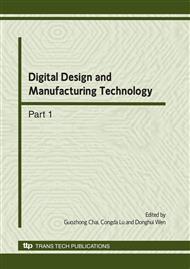p.252
p.257
p.262
p.267
p.272
p.277
p.283
p.288
p.292
Modal Analysis of Precision Lapping Machine
Abstract:
A new method was used to analysis the performance of Nano-MAX lapping machine under working condition. Model analysis in ANSYS and operational model analysis in LMS Test.Lab are banded together properly, which reduce the calculation difficulty. Time frequency analysis method is also used to study in which speed is the most suitable one for processing of Nano-MAX lapping machine. Model analysis results reveal that 100Hz is the natural frequency of chassis and the workbench and 178Hz is the natural frequency of chassis and spindle outer covering. If the exciting frequency is 100Hz or 178Hz, there will be two mechanical parts set up resonance which will likely to cause the whole machine resonance.
Info:
Periodical:
Pages:
272-276
Citation:
Online since:
March 2010
Authors:
Keywords:
Price:
Сopyright:
© 2010 Trans Tech Publications Ltd. All Rights Reserved
Share:
Citation:


